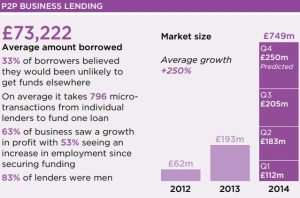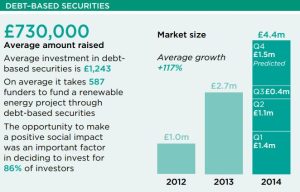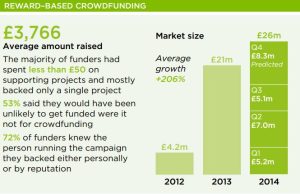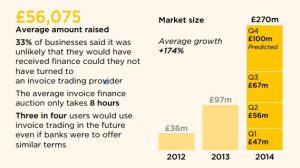What is P2P Business Lending Debt–based transactions between individuals and existing businesses – which are mostly SMEs with many individual lenders contributing to any one loan. .

The market has more than tripled in size since 2013 P2P business lending facilitates secured or non–secured business loans between individual lenders to mostly SMEs. Over the last two years P2P business lending has experienced an impressive growth, with a 288 per cent increase from the £193 million in 2013 to a predicted £749 million in 2014.
This growth can be largely attributed to the strong expansion of existing industrial players as well as the recent proliferation of this business model underpinned with the emergence of many new and diverse entrants into the market.
Lenders are creating large portfolios as lending is split among hundreds of borrowers Analysis of primary transactional data from P2P business lending platforms worth £309 million covering over 3,000 loans and 3.18 million transactions from 2011–2013 illustrates that the average business interest rate paid is around 8.8 per cent. The average P2P business lending loan size is £73,222 and it takes approximately 796 transactions from individual lenders to the business borrower to fund a listed loan, with the average loan being just £91.95. P2P business lenders have, on average, a sizeable lending portfolio of £8,137 spread over a median of 52 business loans.
Manufacturing businesses using P2P borrowing most Of 3,112 P2P business loans analysed, the top three most funded industrial sectors are manufacturing, professional and business services and retail. P2P lending for real estate finance also emerging One of the fastest–growing markets within the P2P business lending model is secured lending for real estate mortgages and developments.
For this particular section of the market, which was analysed separately, we found that the average business loan amount is considerable higher at £662,425 with an average loan term of 10 months. In addition to looking at transactional data from platforms, we also surveyed 1,771 lenders and 323 business borrowers who have used P2P business lending, to attain further insights on their behaviour and views on alternative finance.
The survey results mirror the findings from the platform data with 30 per cent having lent between £1,000 and £5,000 and 26 per cent having lent between £5,000 and £20,000. It is however interesting to note that almost 23 per cent have provided loans in the range from £20,000 to £100,000. Also corresponding to the findings from transactional data from platforms, our survey demonstrates that P2P business lenders do actively diversify their lending portfolios. One in four P2P business lenders has lent to more than 100 businesses, and 45 per cent have lent to between 20 and 100 businesses.
Lenders tend to be older males using money set aside for savings or investment P2P business lending is primarily used by men who are 55 or older. Eighty–three per cent of surveyed lenders, and 74 per cent of borrowers were men. Fifty–seven per cent of lenders were 55 or older.
They were also quite wealthy with a third having an annual income in excess of £50,000. The majority of P2P business lenders learned about this alternative finance model through online advertising (28 per cent) and online intermediaries such as MoneySupermarket (25 per cent).
When budgeting for lending through P2P business lending platforms, it is clear that the money primarily comes from lenders’ investment budget (54 per cent) or their savings (45 per cent). Very few people (less than 2 per cent) have lent money they would otherwise use for day–to–day spending. Lenders are primarily motivated by the financial return available The main reason why people use P2P business lending to lend is to make a financial return on investment, with 82 per cent of respondents stating this as very important in their decision.
Building on this, many also stated the service that P2P business lending offers, in terms of the ease of lending process (important or very important to 87 per cent), diversifying investment portfolios (important or very important to 88 per cent) and having control over where the lent money is going (important or very important to 81 per cent) were key to their decision to lend. Unlike the donation and reward–based fundraising, the opportunity to use the P2P business lending model to support a specific sector or industry, supporting friends and family or supporting a social cause was of relatively low importance to the majority of lenders.
Furthermore, it is interesting to observe that almost none of the P2P business lenders had personal connections to the businesses they lent to, with 97 per cent saying their first loan was to someone they didn’t know. Registered but inactive lenders concerned by business creditworthiness We also asked those lenders who have set up accounts with P2P business lending platforms but have yet to make their first loan (5 per cent of all surveyed lenders) what would make them start lending.
The key issue ranked important or very important by these potential lenders was uncertainty about the creditworthiness of business seeking loans (73 per cent of respondents). Uncertainty about how the model worked was not one of the more cited factors with 35 per cent saying this was ‘important’ or ‘very important’. Inactive members highlighted more information about businesses seeking loans (13 per cent), greater tax incentives (31 per cent) and more information about risks associated with lending (11 per cent) as three key factors that would make them begin lending.
Finally, 58 per cent of the surveyed inactive lenders indicated that they would start lending within the next 12 months. Borrower seeking growth or working capital and value speed of service Businesses seeking to borrow via P2P business lending most commonly seek a loan for expansion and/or growth capital (41 per cent) and working capital (34 per cent). SMEs borrowers often choose P2P business lending because the combination of the speed and ease of use of the model, rated important or very important by 94 per cent and 90 per cent of borrowers respectively.
91 per cent of borrowers highlight how they see P2P business lending as an easier way to get funded than traditional channels (e.g. bank) as a key factor in their decision to choose this lending model. P2P business lending is funding many borrowers who would otherwise struggle Responses show that borrowers in many instances have unsuccessfully sought funding from more traditional funders such as banks before attempting to borrow via P2P business lending platforms.
79 per cent of borrowers had attempted to get a bank loan before turning to P2P business Lending, with only 22 per cent of borrowers being offered a bank loan. 33 per cent thought it was unlikely or very unlikely that they would have been able to secure funding elsewhere had they not been successful in getting a loan through the P2P business lending platform, whereas 44 per cent of respondents thought they would have been likely or very likely to secure funding from other sources had they not used P2P business lending.
Businesses receiving loans reporting growth in term of job creation and turnover Most business respondents have experienced positive growth since successfully securing a loan. 71 per cent of borrowers reported growth in turnover, 63 per cent experienced growth in profit with 53 per cent having increased their employment.
The majority of the remaining respondents reported that their turnover, profit or employment levels had remained largely the same. Less than 5 per cent reported contraction under any metrics. Growth of model likely to continue in 2015 The rapid growth of P2P business lending is illustrated not just by the increasing amount of money lent to businesses via the model in recent years, but also by the number of people and businesses who have only just started to use the platforms to lend and borrow. More than 69 per cent of P2P business lenders surveyed have begun using the model in just the last two years with half of these starting since the beginning of 2014.
Similar trends exist on the borrower side with 48 per cent of the businesses responding to the survey having first borrowed in 2014 and 40 per cent in 2013. Looking ahead, the majority of P2P business lenders expect to increase their lending in total and to more businesses, with 53 per cent of them expecting to lend more, and 38 per cent of them expecting to lend about the same. In addition, 65 per cent of lenders expect to lend more should their P2P lending qualify for the Individual Savings Account (ISA) scheme. Ninety–four per cent of borrowers state that they will be likely or very likely to approach a P2P business lending platform first if they need finance in the future, and a significant 86 per cent would be likely or very likely to approach a P2P Lending platform even if a bank could offer similar terms. Ninety–seven per cent would be likely or very likely to recommend P2P business lending to other business that they know are seeking funding. Current lenders’ support for the P2P business lending model is emphasized by the fact that 59 per cent of lenders are very likely to recommend P2P business lending to others with money to lend, and 42 per cent of them are very likely to recommend P2P business lending to business looking to borrow money.





